I was embarrassed, on looking at old Pi Day Reading the Comics posts, to see how often I observed there were fewer Pi Day comics than I expected. There was not a shortage this year. This even though if Pi Day has any value it’s as an educational event, and there should be no in-person educational events while the pandemic is still on. Of course one can still do educational stuff remotely, mathematics especially. But after a year of watching teaching on screens and sometimes doing projects at home, it’s hard for me to imagine a bit more of that being all that fun.
But Pi Day being a Sunday did give cartoonists more space to explain what they’re talking about. This is valuable. It’s easy for the dreadfully online, like me, to forget that most people haven’t heard of Pi Day. Most people don’t have any idea why that should be a thing or what it should be about. This seems to have freed up many people to write about it. But — to write what? Let’s take a quick tour of my daily comics reading.

Tony Cochran’s Agnes starts with some talk about Daylight Saving Time. Agnes and Trout don’t quite understand how it works, and get from there to Pi Day. Or as Agnes says, Pie Day, missing the mathematics altogether in favor of the food.

Scott Hilburn’s The Argyle Sweater is an anthropomorphic-numerals joke. It’s a bit risqué compared to the sort of thing you expect to see around here. The reflection of the numerals is correct, but it bothered me too.
![Lupin, white cat, reporting: 'It's National Pie Day! [ Handed a bulletin ] Excuse me?' A chart shows a circle, diameter, circumference, and radius. Puck, black cat, interrupts, wearing a T-shirt with pi on it: 'It's Pi Day! When folks celebrate the mathematical constant pi! Not to be confused with the pastry dessert pie! Though people celebrate it by baking and eating pies.' (See The Woman and her child rolling out pie crust in the kitchen.) 'Which is very confusing! Just like math ... ' Agnes, mouse: 'No way, Puck! Check it out!' Agnes shows the pi = C / D formula on a card, and with some other mice demonstrates: 'Measure the circumference of the pie with a ribbon. Now, measure the diameter across and cut the ribbon each time. You should be left with three equal ribbons and a little extra! 3.14, that's pi!' Puck looks at the pie, with a slice cut out: 'Hey, where did this radius-slice go?' Agnes: 'OUR WORK HERE IS DONE!' Other mouse: 'MATH RULES!'](https://nebusresearch.wordpress.com/wp-content/uploads/2021/03/breaking-cat-news_georgia-dunn_14-march-2021.jpeg?w=840)
Georgia Dunn’s Breaking Cat News is a delightful cute comic strip. It doesn’t mention mathematics much. Here the cat reporters do a fine job explaining what Pi Day is and why everybody spent Sunday showing pictures of pies. This could almost be the standard reference for all the Pi Day strips.
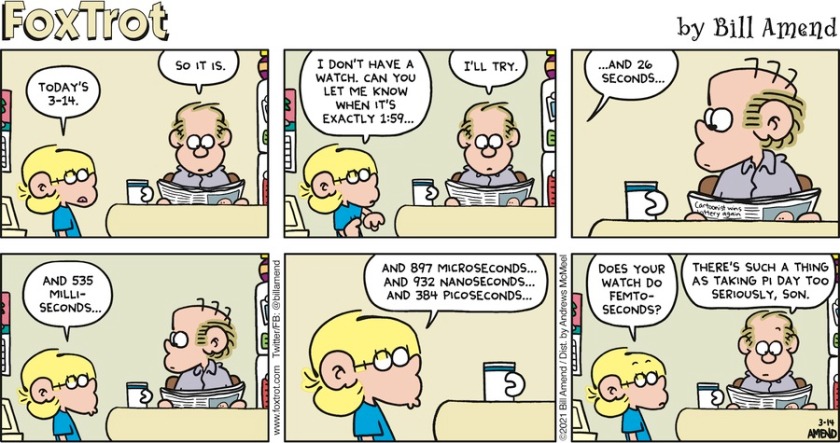
Bill Amend’s FoxTrot is one of the handful that don’t mention pie at all. It focuses on representing the decimal digits of π. At least within the confines of something someone might write in the American dating system. The logic of it is a bit rough but if we’ve accepted 3-14 to represent 3.14, we can accept 1:59 as standing in for the 0.00159 of the original number. But represent 0.0015926 (etc) of a day however you like. If we accept that time is continuous, then there’s some moment on the 14th of March which matches that perfectly.

Jef Mallett’s Frazz talks about the eliding between π and pie for the 14th of March. The strip wonders a bit what kind of joke it is exactly. It’s a nerd pun, or at least nerd wordplay. If I had to cast a vote I’d call it a language gag. If they celebrated Pi Day in Germany, there would not be any comic strips calling it Tortentag.

Steenz’s Heart of the City is another of the pi-pie comics. I do feel for Heart’s bewilderment at hearing π explained at length. Also Kat’s desire to explain mathematics overwhelming her audience. It’s a feeling I struggle with too. The thing is it’s a lot of fun to explain things. It’s so much fun you can lose track whether you’re still communicating. If you set off one of these knowledge-floods from a friend? Try to hold on and look interested and remember any single piece anywhere of it. You are doing so much good for your friend. And if you realize you’re knowledge-flooding someone? Yeah, try not to overload them, but think about the things that are exciting about this. Your enthusiasm will communicate when your words do not.

Dave Whamond’s Reality Check is a pi-pie joke that doesn’t rely on actual pie. Well, there’s a small slice in the corner. It relies on the infinite length of the decimal representation of π. (Or its representation in any integer base.)

Michael Jantze’s Studio Jantze ran on Monday instead, although the caption suggests it was intended for Pi Day. So I’m including it here. And it’s the last of the strips sliding the day over to pie.
But there were a couple of comic strips with some mathematics mention that were not about Pi Day. It may have been coincidence.

Sandra Bell-Lundy’s Between Friends is of the “word problem in real life” kind. It’s a fair enough word problem, though, asking about how long something would take. From the premises, it takes a hair seven weeks to grow one-quarter inch, and it gets trimmed one quarter-inch every six weeks. It’s making progress, but it might be easier to pull out the entire grey hair. This won’t help things though.

Darby Conley’s Get Fuzzy is a rerun, as all Get Fuzzy strips are. It first (I think) ran the 13th of September, 2009. And it’s another Infinite Monkeys comic strip, built on how a random process should be able to create specific outcomes. As often happens when joking about monkeys writing Shakespeare, some piece of pop culture is treated as being easier. But for these problems the meaning of the content doesn’t count. Only the length counts. A monkey typing “let it be written in eight and eight” is as improbable as a monkey typing “yrg vg or jevggra va rvtug naq rvtug”. It’s on us that we find one of those more impressive than the other.
And this wraps up my Pi Day comic strips. I don’t promise that I’m back to reading the comics for their mathematics content regularly. But I have done a lot of it, and figure to do it again. All my Reading the Comics posts appear at this link. Thank you for reading and I hope you had some good pie.
I don’t know how Andertoons didn’t get an appearance here.






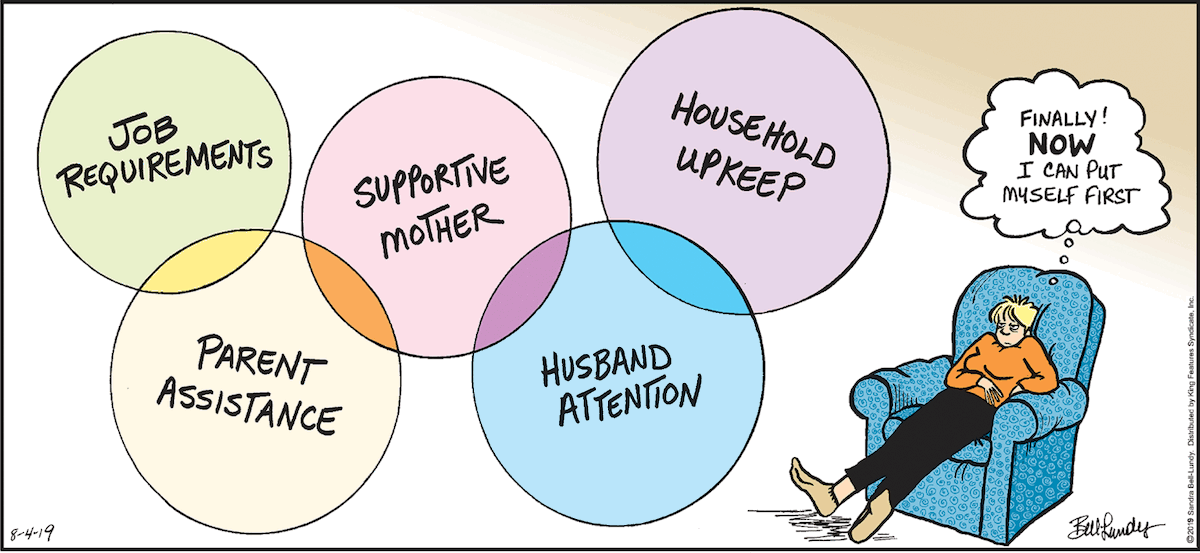

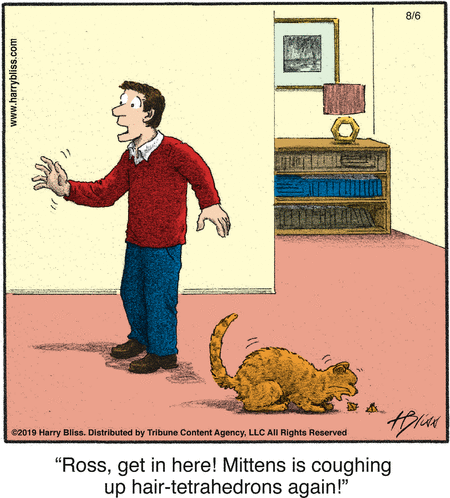
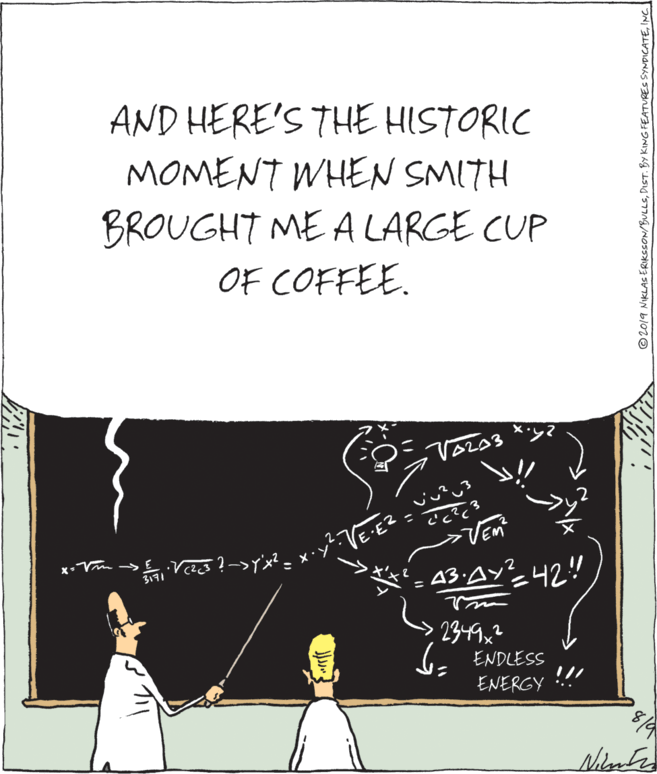

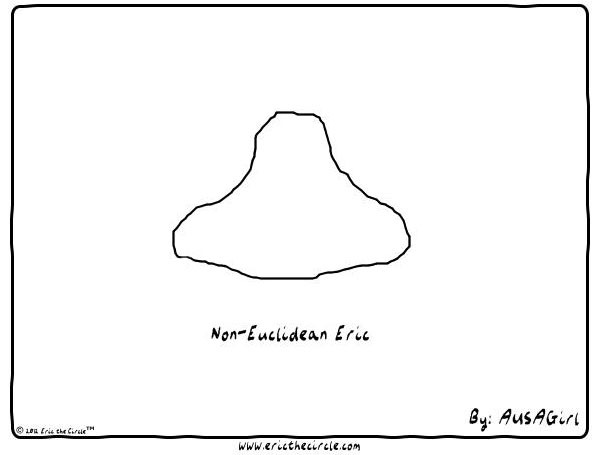

![[ The Venn Diagram of Living your Best Life ] The balloons are 'Did Do' and 'Didn't Do', with the overlap 'Regret'.](https://nebusresearch.wordpress.com/wp-content/uploads/2018/10/sandra-bell-lundy_between-friends_1-october-2018.gif)




